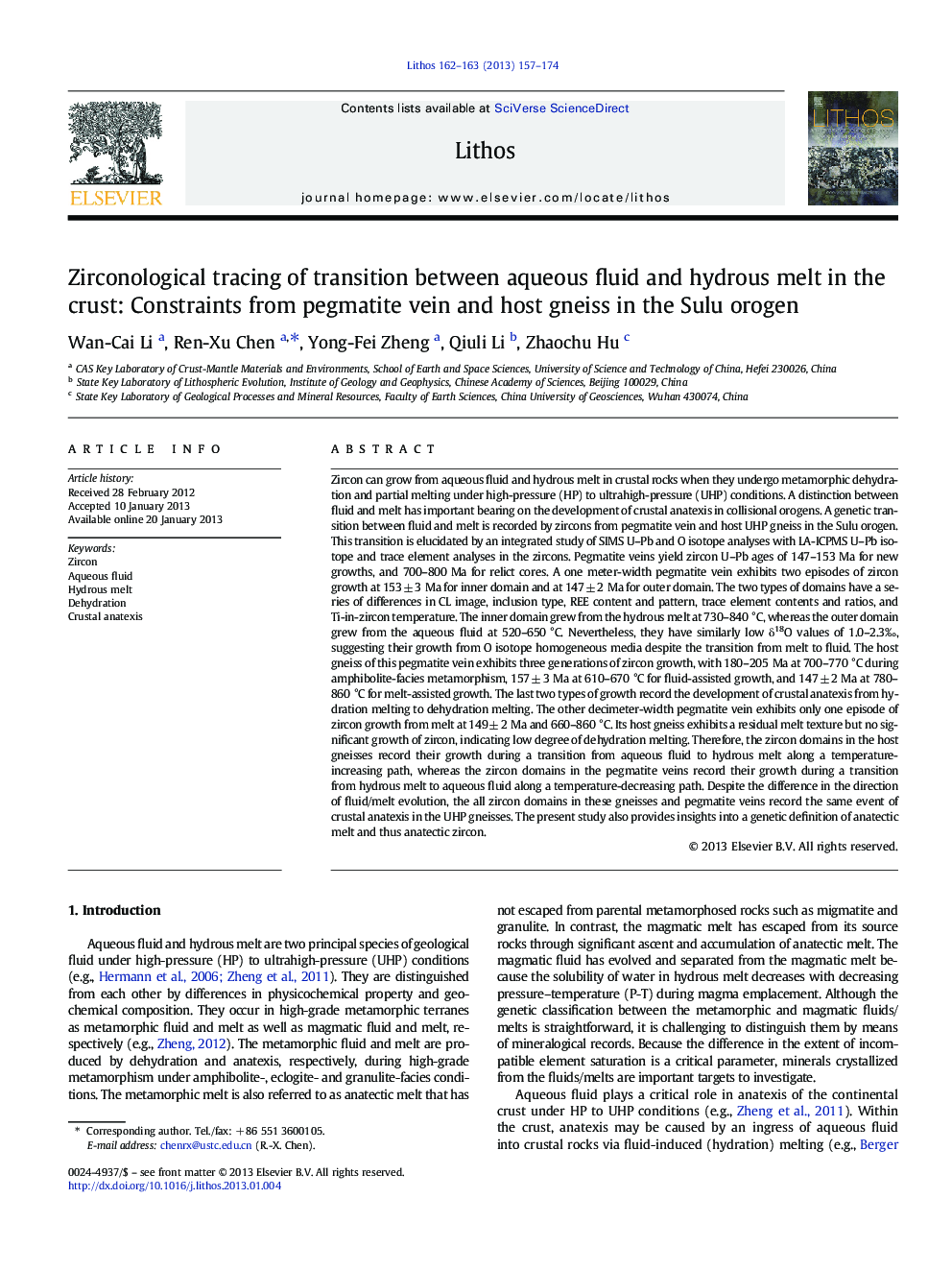| کد مقاله | کد نشریه | سال انتشار | مقاله انگلیسی | نسخه تمام متن |
|---|---|---|---|---|
| 4716290 | 1638695 | 2013 | 18 صفحه PDF | دانلود رایگان |

Zircon can grow from aqueous fluid and hydrous melt in crustal rocks when they undergo metamorphic dehydration and partial melting under high-pressure (HP) to ultrahigh-pressure (UHP) conditions. A distinction between fluid and melt has important bearing on the development of crustal anatexis in collisional orogens. A genetic transition between fluid and melt is recorded by zircons from pegmatite vein and host UHP gneiss in the Sulu orogen. This transition is elucidated by an integrated study of SIMS U–Pb and O isotope analyses with LA-ICPMS U–Pb isotope and trace element analyses in the zircons. Pegmatite veins yield zircon U–Pb ages of 147–153 Ma for new growths, and 700–800 Ma for relict cores. A one meter-width pegmatite vein exhibits two episodes of zircon growth at 153 ± 3 Ma for inner domain and at 147 ± 2 Ma for outer domain. The two types of domains have a series of differences in CL image, inclusion type, REE content and pattern, trace element contents and ratios, and Ti-in-zircon temperature. The inner domain grew from the hydrous melt at 730–840 °C, whereas the outer domain grew from the aqueous fluid at 520–650 °C. Nevertheless, they have similarly low δ18O values of 1.0–2.3‰, suggesting their growth from O isotope homogeneous media despite the transition from melt to fluid. The host gneiss of this pegmatite vein exhibits three generations of zircon growth, with 180–205 Ma at 700–770 °C during amphibolite-facies metamorphism, 157 ± 3 Ma at 610–670 °C for fluid-assisted growth, and 147 ± 2 Ma at 780–860 °C for melt-assisted growth. The last two types of growth record the development of crustal anatexis from hydration melting to dehydration melting. The other decimeter-width pegmatite vein exhibits only one episode of zircon growth from melt at 149 ± 2 Ma and 660–860 °C. Its host gneiss exhibits a residual melt texture but no significant growth of zircon, indicating low degree of dehydration melting. Therefore, the zircon domains in the host gneisses record their growth during a transition from aqueous fluid to hydrous melt along a temperature-increasing path, whereas the zircon domains in the pegmatite veins record their growth during a transition from hydrous melt to aqueous fluid along a temperature-decreasing path. Despite the difference in the direction of fluid/melt evolution, the all zircon domains in these gneisses and pegmatite veins record the same event of crustal anatexis in the UHP gneisses. The present study also provides insights into a genetic definition of anatectic melt and thus anatectic zircon.
► Zircon domains grown from aqueous fluid and hydrous melt are identified in pegmatite vein and host gneiss.
► The progress of dehydration melting is indicated by a genetic transition from fluid to melt in the gneiss.
► The effect of mineral crystallization is indicated by a genetic transition from melt to fluid in the pegmatite vein.
► Breakdown of hydrous minerals in the gneiss is responsible for fluid focus and crustal anatexis.
► Anatectic zircon is distinguished from magmatic zircon by a series differences in trace element composition.
Journal: Lithos - Volumes 162–163, March 2013, Pages 157–174